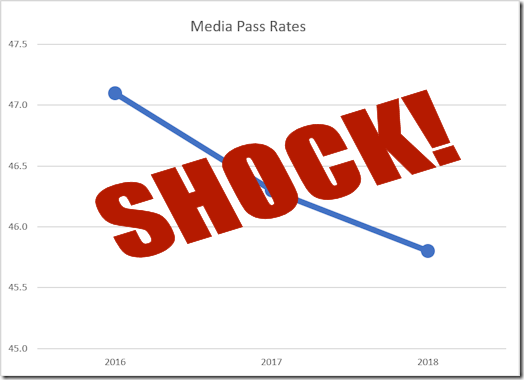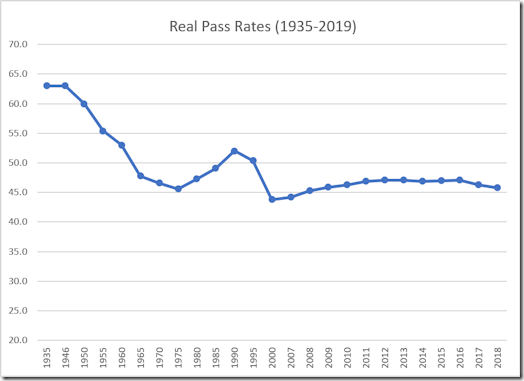
A few days ago, the media was awash with reports about how the driving test pass rate had plummeted, and it was all because of the “new parallel parking manoeuvre” that had been introduced. It was a great opportunity for ADIs who have been against “it” from the start to give their two penn’orth.
Although the link above was from The Telegraph, the Daily Mail ran the same illiterate crap, and several others followed. Comic news site, Yahoo, even went so far as to blame the same “new” manoeuvre on a separate FOI request, which revealed one candidate took 21 tests in a single year.
It seems that in the world of newspapers, someone who has just been given their first job in journalism does one of these FOIs every year. I think it must be some sort of induction test to make sure they can fill in an online form properly. And every year, without fail, there is someone somewhere who has taken an ungodly number of tests before passing (and some of them still haven’t passed, even then). It is a separate statistic which is independent of how easy or hard the test is. It merely shows that just as some people are crap journalists, there are others who are crap drivers and perhaps ought never to be allowed to drive. Ever. But it is separate.
The really laughable part is the reference to this “new parallel parking manoeuvre” – all the more laughable since there are ADIs who have allowed themselves to be associated with the claims. Because there IS no new parallel parking manoeuvre! Even some joker representing a querulous organisation which, in a previous incarnation, specialised in stirring things, ranted about how “dangerous” it is without clarifying the glaring naming error (perhaps because he didn’t know himself).
What there actually is is a piss-easy manoeuvre which involves checking your mirrors and looking ahead to make sure it’s clear, pulling over on the right-hand side of the road, then reversing back a couple of car lengths without ending up on the pavement or on the other side of the road again, and finally driving off and going back over on to the correct side safely. It’s the kind of thing any 17 year old is going to be doing 5 minutes after he passes when he sees one of his mates on the other side of the road.
The manoeuvre is referred to as “pulling up on the right”, “stopping on the right”, or similar phrases. And it is not a “parallel parking manoeuvre”.
It’s only dangerous if people haven’t been taught to do it properly. Mine have to do it on busy roads in Long Eaton and with oncoming/passing/parked lorries on a busy industrial estate in Colwick, and the only problem I’ve had was when someone decided for reasons not even known to himself to turn the wheel on to half lock as he reversed and veered outwards (and since he didn’t notice until I showed it to him on the dashcam, it was probably best he was caught early anyway). A disproportionate number of tests seem to include it, and I thought they’d pull back on it after the original introduction – where virtually every test did it – but they haven’t.
The media has claimed that the pass rate has plummeted. They base this ridiculous statement on something like the graph at the top of this article – which shows the national pass rate for the last three years. I have carefully adjusted the axes to make it look as bad as possible, just like pretty much every journalist does when they’re talking about numbers. Yet it is only a little over 1% decline over three years. If you ignore the fact that life has been going on for more than the last three years, it looks like the pass rate is on a downward slope into oblivion – even if it would take over 40 years to get to zero at the rate it is going.
However, if you look at pass rates since the introduction of the driving test in 1935, a completely different story emerges.

I cut these data down to one approximately every 5 years up until 2007, and from there on the data are yearly. Because of that, and also because I started the y-axis at 20% instead of 0%, they look a bit more dramatic than they are (i.e. the right half of the graph covers 19 years, whereas the left half covers 65 years – imagine the 1935-2000 part stretched out to three times wider).
Something odd happened between 1975 and 1990, and between 1990 and 2000 (a rise followed by a fall). But since 2000 the pass rate has been virtually flat – hovering between 44% and 47%. It is currently at about 46%, and there are no blips or drops worth a mention (i.e. any changes to the test have neither improved or worsened pass rates to any significant extent).
As I said, the top graph shows what you can do if you don’t represent data properly, and the message that comes across if you’re an ADI or journalist who doesn’t understand data is both confused and wrong.
The only time the pass rate has been significantly higher than it is now was in a different era. No internet, no smartphones, dial phones wired to the house, two postal deliveries a day (one of them before you got up), bottled milk on the doorstep, outside toilets, bin men who actually carried bins overflowing with filth and tipped them in the back of a truck, anything up to 1,000 times fewer cars on the road, no motorways, no roundabouts, and so on. DVSA does itself no favours harping on about training standards being the issue when the pass rate is hovering around 45%. It’s just the norm, and has been for almost 20 years – and up to more than 50 years if you allow a few percent extra variance.
One thing is certain. The pass rate has not fallen (or risen) significantly for the last 20 years. And the proper graph clearly shows its not likely to change much in the next 20 either – unless some idiot forces it to. I try not to say bad things about them, but I’m sure DVSA is disappointed that the 2019 data point isn’t joined by an almost vertical line up at 90%, and will likely blame this on poor training again.
Oh, I almost forgot to mention. The reason I wrote this is that DVSA has had to send out an email correcting the false media stories.